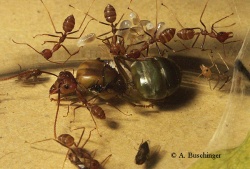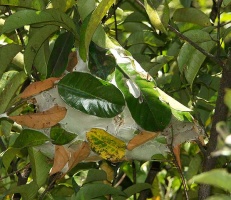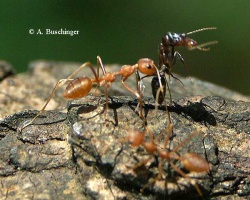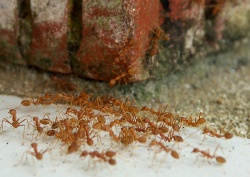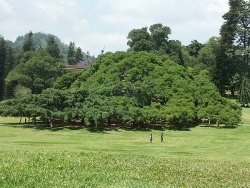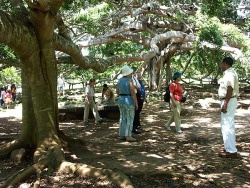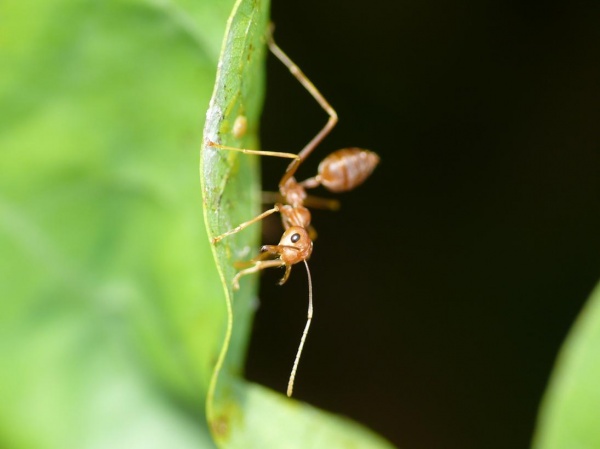Oecophylla smaragdina
| Dieser Artikel wurde zur Überarbeitung vorgeschlagen. Hilf mit, ihn zu verbessern!
Begründung: Die Linkwüste bräuchte eine Überarbeitung, und der hintere Teil des Artikels bräuchte ein wenig Ordnung. Gallerien sind nur vorläufig. |
Oecophylla smaragdina, auch "Asiatische Weberameise" genannt, ist eine Ameisenart aus dem asiatisch-, australischen Raum, die dort recht großflächig verbreitet ist. Innerhalb der Gattung Oecophylla, die der Unterfamilie der Formicinae angehört, existieren lediglich zwei rezente Arten, Oecophylla smaragdina, die in Südostasien und Australien beheimatet ist, sowie die afrikanische Oecophylla longinoda.
Der Name Artname „smaragdina“ weist auf eine grüne oder grünliche Färbung hin. Im größten Teil des Verbreitungsgebietes sind die Tiere jedoch rotbraun. Nur die Königin hat stets eine grün gefärbte Gaster. Wirklich grün gefärbte Arbeiterinnen kommen allerdings im feucht-tropischen Australien vor.
Lebensweise
Bekannt sind die Weberameisen dafür, dass sie mit Hilfe ihrer Larven Blattbüschel zusammenspinnen und sich damit in Baumkronen Nester konstruieren. Das Seidensekret stammt aus den Speicheldrüsen der Larven. Normalerweise wird es bei Formicinae für die Herstellung der Puppenkokons benutzt.
Merkmale
Die Völker sind monogyn (oder auch polygyn), erreichen jedoch eine sehr hohe Population. Ein Volk kann über 100 solcher Nester umfassen und mehrere benachbarte Bäume beherrschen. `Oecophylla smaragdina lebt räuberisch und nimmt zusätzlich Nektar und Honigtau als Nahrung auf. Die Tiere beißen recht kräftig und spritzen anschließend Ameisensäure in die kleine Wunde. Ein Zusammentreffen mit einer großen Menge Weberameisen kann somit recht schmerzhaft sein. Die Koloniegründung ist claustral, wobei sich die Königin allerdings oft nur auf oder unter einem Blatt festsetzt und dort sehr rasch ihre ersten Arbeiterinnen aufzieht.
Derselbe Baum dient als schattiger Picknickplatz für hitzegestresste Touristen. Aus Luftwurzeln wachsen nach Erreichen des Bodens neue Stämme, es entwickelt sich ein „Wäldchen“, das aus einem einzigen Baum besteht. Links vorn ein solcher Sekundärstamm, über einen langen Ast ist er mit dem ursprünglichen Stamm hinten verbunden. Oecophylla smaragdina hat somit etliche Möglichkeiten Zugang zum Boden zu finden.
Bild 7: Eine Arbeiterin aus Mui ne, Südvietnam.
Literaturhinweise:
Bereits 1998 erschien eine Arbeit von Peng & al., in der Polygynie bei nordaustralischen O. smaragdina nachgewiesen wurde. Die Zusammenfassung wurde allerdings erst 2007 ins Netz gestellt:
http://www3.interscience.wiley.com/journal/119134402/abstract?CRETRY=1&SRETRY=0
RK Peng , K Christian & K Gibb (1998): How many queens are there in mature colonies of the green ant, Oecophylla smaragdina (Fabricius)? - Australian Journal of Entomology 37, 249 – 253. (Published Online: 31 Mar 2007)
Keywords: green tree ant • pleometrosis • polygyny • queen number.
Abstract:
In an ongoing study of the green ant, Oecophylla smaragdina (Fabricius), to control insect pests, we surveyed newly established ant colonies in a 3-year-old mango block in March 1997 at Howard Springs, Northern Territory. We also surveyed 12 established ant colonies from May to July 1997 in Darwin, and six of them were surveyed again in February 1998. The aims were to determine patterns of initial colonisation by dealate queens of O. smaragdina and to locate the queen ant nest in established colonies of the ant. The number of dealate queens in new communal nests varied from one to 15. In a total of 73 nests, 71% of nests contained more than one dealate queen and 12% of nests contained segments or corpses of dealate queens, which were either parasitised by a fungus or killed by predators. This confirms that pleometrosis during the initial establishment of a colony is very common in O. smaragdina, and suggests that natural enemies affect the success of initial colonisation. Of 12 established green ant colonies, 10 colonies with two to six queens were all in one nest, and only two colonies had one queen. In those colonies with multiple queens, we found that each queen was almost equally attractive to the major workers. Contrary to previous reports, these data suggest that pleometrosis in O. smaragdina during the initial period of colony establishment can lead to polygyny in mature colonies. This is the first time that polygyny has been documented in mature colonies of O. smaragdina.
Ein weiterer Artikel (vom Januar 2009) informiert über Polygynie bei O. smaragdina aus Nordaustralien. Weiterhin werden weniger als die Hälfte der Königinnen von nur einem Männchen begattet. Manche kopulieren mit bis zu 5 Männchen.
http://www.ingentaconnect.com/content/bsc/mecol/2009/00000018/00000001/art00016
SCHLÜNS, E.A.; WEGENER, B.J.; SCHLÜNS, H.; AZUMA, N.; ROBSON, S. K. A.; CROZIER, R. H. (2009): Breeding system, colony and population structure in the weaver ant Oecophylla smaragdina. Molecular Ecology 18, 156-167
Abstract:
Weaver ants (Oecophylla smaragdina) are dominant ants in open forests from India, Australia, China and Southeast Asia, whose leaf nests are held together with larval silk. The species, together with its sole congener O. longinoda, has been important in research on biological control, communication, territoriality and colony integration. Over most of the range, only one queen has been found per colony, but the occurrence of several queens per nest has been reported for the Australian Northern Territory. The number of males mating with each queen is little known. Here we report on the colony structure of O. smaragdina using published and new microsatellite markers. Worker genotype arrays reflect the occurrence of habitual polygyny (more than one queen per colony) in 18 colonies from Darwin, Northern Australia, with up to five queens inferred per colony. Monogyny (one queen per colony) with occasional polygyny was inferred for 14 colonies from Queensland, Australia, and 20 colonies from Java, Indonesia. Direct genotyping of the sperm carried by 77 Queensland queens and worker genotypic arrays of established colonies yielded similar results, indicating that less than half of the queens mate only once and some mate up to five times. Worker genotype arrays indicated that queens from Java and the Northern Territory also often mate with more than one male, but less often than those from Queensland. A strong isolation-by-distance effect was found for Queensland samples. The variation uncovered means that O. smaragdina is a more versatile study system than previously supposed.
---
Ein Beitrag über Oecophylla-Farming ist hier enthalten: http://www.ameisenwiki.de/index.php/Aktuelle_Ereignisse#Band_3_der_Zeitschrift_.22Asian_Myrmecology.22_ist_erschienen_.281._Mai_2010.29
Weblinks
Haltungsberichte:
- Bericht über die Haltung von O. smaragdina. Zu beachten: Am Ende ist von vielen Ausbrüchen die Rede - ameisenforum.de
- weiterer Bericht über die Haltung von O. smaragdina, hier in einem "Reagenzglasbaum"
- Foto-Bericht über die Haltung von O. smaragdina - Facebook.com
Filme:
- ein paar Links zu Youtube-Filmchen über Oecophylla smaragdina. Es ist die ganz grüne Form, vermutlich aus Queensland:
- Oecophylla smaragdina webend, anscheinend in der Öffnung eines Reagenzglases: http://youtube.com/watch?v=SFL3RomWmkA
- O. smaragdina - Umzug mit Königin: http://youtube.com/watch?v=i4TW9occTO0
- O. smaragdina, Königin bei der Ankunft im neuen „Nest“: http://youtube.com/watch?v=eS57aVbxZR8
- die rötliche Form beim Nestbau: https://www.youtube.com/watch?v=9pdAOS7Jr8s

